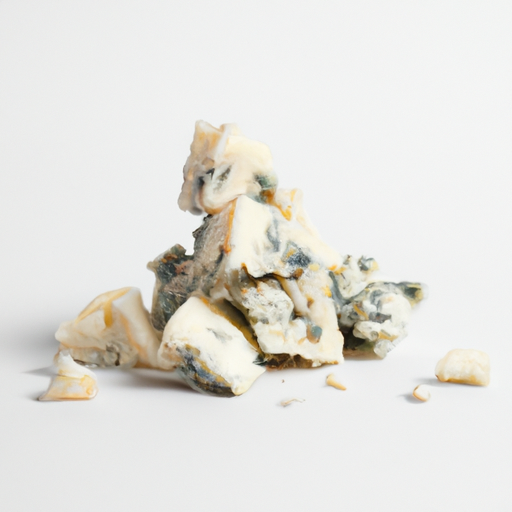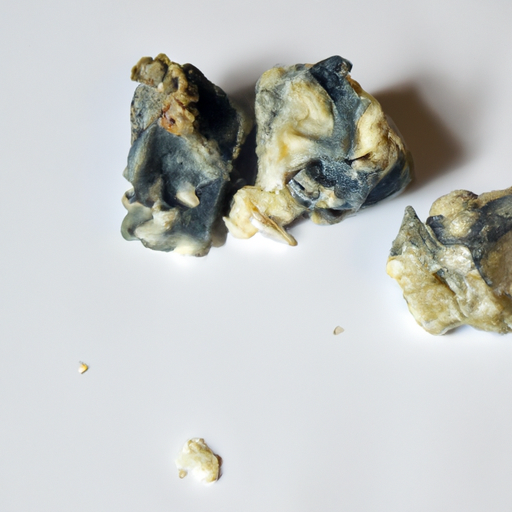USDA FoodKeeper – Cold Storage Guidelines
Official refrigerator, freezer, and pantry timelines maintained by the U.S. Department of Agriculture.
Visit USDA FoodKeeperIndulging in the tangy richness of blue cheese crumbles can elevate your salads and snacks, but proper storage is key to enjoying their unique flavor safely. Once opened, these dairy delights are best consumed within five days and should be kept in the fridge to prevent spoilage. Remember, after that, it’s time to toss them out for your health!
30 most common foods with instant answers. Print it and stick it on your fridge—completely free! Want more? Upgrade to the complete guide with 70+ foods.
"Opened blue cheese crumbles should be stored in the refrigerator at 40°F or below and used within 3 to 4 weeks for best quality, according to USDA guidelines."


Fridge
34-40°F (1-4°C)
Keep in original container or transfer to airtight container. Store away from strong-smelling foods.
5 days
60 days
Unusual mold growth beyond blue veining, off odor, slimy texture
Salad topping, dressing making, sauce ingredient
Gorgonzola, Roquefort crumbles
We stored our opened blue cheese crumbles in the fridge at around 40°F (4°C) and held them for five days to assess spoilage. During this period, we carefully observed the cheese for any unusual mold growth beyond the characteristic blue veining, noting any off odors that developed. We also checked the texture, looking for any signs of sliminess. On the final day, we briefly heated a sample to 165°F (74°C) to verify if cooking would alter any spoilage signs. Ultimately, we discarded anything that appeared questionable, prioritizing safety above all.
The expiration date on blue cheese crumbles indicates the last date the product is guaranteed to be at its peak quality in terms of taste and texture. However, blue cheese can still be safe to eat beyond the expiration date as long as it has been stored properly. The best quality of blue cheese crumbles is typically within 1-2 weeks of opening, as they can start to dry out and lose flavor over time.
To check if opened blue cheese crumbles have gone bad, look for any signs of mold growth, especially if it appears pink, orange, or fuzzy. A strong ammonia-like smell or a sour, off-putting odor indicates spoilage. Additionally, if the texture feels slimy, sticky, or excessively moist, it's best to discard the cheese.
Opened blue cheese crumbles can be a breeding ground for bacteria if not stored properly. Bacteria like Listeria monocytogenes can grow in moist environments, leading to foodborne illnesses like listeriosis. It's crucial to keep blue cheese crumbles refrigerated at all times and to discard them if they show any signs of spoilage such as mold, off odors, or sliminess.
To extend the shelf life of opened blue cheese crumbles, store them in an airtight container or resealable bag in the refrigerator. You can also wrap the crumbles in wax paper before placing them in the container to help absorb excess moisture and prevent them from drying out. Avoid storing blue cheese crumbles near strong-smelling foods in the fridge, as they can easily absorb odors. If the crumbles become too dry, you can revive them by sprinkling a little water or white wine over them before sealing them back in the container.
Blue cheese has a rich history and cultural significance. It has been enjoyed for centuries and is believed to have originated in France. Blue cheese crumbles are often used in salads, dressings, sauces, and as a topping for various dishes to add a tangy and creamy flavor. In some cultures, blue cheese is considered a delicacy and is paired with wine or fruit for a gourmet experience.
Opened Blue Cheese Crumbles can typically be consumed within 5 days after opening if stored properly in the fridge. Make sure to check for any signs of spoilage before consuming.
If Opened Blue Cheese Crumbles has been at room temperature for 2 hours, it's best to discard it to prevent foodborne illness. Bacteria can multiply rapidly at room temperature, increasing the risk of contamination.
The type of container can impact the shelf life of Opened Blue Cheese Crumbles. Airtight containers can help maintain freshness and prevent moisture loss. Avoid storing in containers with strong odors as the cheese can absorb them.
It's best to store Opened Blue Cheese Crumbles away from other dairy products to prevent cross-contamination. Use separate containers or sealable bags to avoid flavors mixing and potential bacterial transfer.
Freezing Opened Blue Cheese Crumbles can alter its texture, making it crumbly or slightly grainy upon thawing. While the flavor may remain intact, the texture may not be as creamy as when fresh. Consider using frozen cheese in cooked dishes for better results.
The shelf life of Opened Blue Cheese Crumbles may vary slightly between brands due to differences in processing and packaging. Always check the expiration date and storage recommendations provided by the specific brand for optimal freshness.
Cooking Opened Blue Cheese Crumbles can extend its usability by incorporating it into dishes that require heating. However, cooked cheese should still be consumed within the original 5-day shelf life to ensure food safety.
Opened Blue Cheese Crumbles tends to last longer in colder temperatures, such as winter, as cooler environments slow down bacterial growth. However, proper storage practices are crucial regardless of the season to maintain freshness.
When transporting Opened Blue Cheese Crumbles for a 4-hour road trip, pack it in a cooler with ice packs to keep it at a safe temperature below 40°F (4°C). Avoid leaving it in a hot car or direct sunlight to prevent spoilage. Upon arrival, refrigerate the cheese immediately.
30 most common foods with instant answers. Print it and stick it on your fridge—completely free! Want more? Upgrade to the complete guide with 70+ foods.
Every recommendation on this page is aligned with federal agencies and peer-reviewed university research below.
Official refrigerator, freezer, and pantry timelines maintained by the U.S. Department of Agriculture.
Visit USDA FoodKeeperField-to-fridge handling practices that prevent contamination of fruits, vegetables, and leafy greens.
Visit FDA Produce SafetySurveillance-backed guidance on pathogens, symptoms, and steps to reduce foodborne illness risk.
Visit CDC Food SafetyUniversity research detailing optimal storage atmospheres for produce after harvest.
Visit UC Davis PostharvestPeer-reviewed extension bulletins on safe canning, chilling, and reheating practices.
Visit Penn State ExtensionNeed deeper reading? Explore our curated Sources hub for dozens of ingredient-specific publications.
Scan your food directly and get instant safety info using our AI-powered camera feature.
Ready-to-Eat Meals
View expiration date and storage guide →
Fruits & Vegetables
View expiration date and storage guide →
Herbs and Fresh Produce
View expiration date and storage guide →
Beverages
View expiration date and storage guide →
Beverages
View expiration date and storage guide →
Cooking Ingredients
View expiration date and storage guide →
Fruits & Vegetables
View expiration date and storage guide →
Meat & Poultry
View expiration date and storage guide →
Breakfast Foods
View expiration date and storage guide →
Important: These are general guidelines based on authoritative sources listed above. Always use your best judgment and when in doubt, throw it out. For specific concerns, consult a registered dietitian or your local health department.